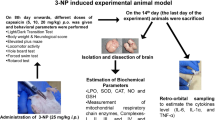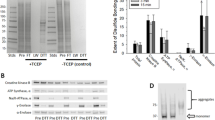Abstract
Neuroprotective approaches comprising different mechanisms to counteract the noxious effects of excitotoxicity and oxidative stress need validation and detailed characterization. Although S-allylcysteine (SAC) is a natural compound exhibiting a broad spectrum of protective effects characterized by antioxidant, anti-inflammatory, and neuromodulatory actions, the mechanisms underlying its protective role on neuronal cell damage triggered by early excitotoxic insults remain elusive. In this study, we evaluated if the preconditioning or the post-treatment of isolated rat cortical slices with SAC (100 μM) can ameliorate the toxic effects induced by the excitotoxic metabolite quinolinic acid (QUIN, 100 μM), and whether this protective response involves the early display of specific antioxidant and neuroprotective signals. For this purpose, cell viability/mitochondrial reductive capacity, lipid peroxidation, levels of reduced and oxidized glutathione (GSH and GSSG, respectively), the rate of cell damage, the NF-E2-related factor 2/antioxidant response element (Nrf2/ARE) binding activity, heme oxygenase 1 (HO-1) regulation, extracellular signal-regulated kinase (ERK1/2) phosphorylation, and the levels of tumor necrosis factor-alpha (TNF-α) and the neurotrophin brain-derived neurotrophic factor (BDNF) were all estimated in tissue slices exposed to SAC and/or QUIN. The incubation of slices with QUIN augmented all toxic endpoints, whereas the addition of SAC prevented and/or recovered all toxic effects of QUIN, exhibiting better results when administered 60 min before the toxin and demonstrating protective and antioxidant properties. The early stimulation of Nrf2/ARE binding activity, the upregulation of HO-1, the ERK1/2 phosphorylation and the preservation of BDNF tissue levels by SAC demonstrate that this molecule displays a wide range of early protective signals by triggering orchestrated antioxidant responses and neuroprotective strategies. The relevance of the characterization of these mechanisms lies in the confirmation that the protective potential exerted by SAC begins at the early stages of excitotoxicity and neurodegeneration and supports the design of integral prophylactic/therapeutic strategies to reduce the deleterious effects observed in neurodegenerative disorders with inherent excitotoxic events.










Similar content being viewed by others
References
Alam J, Stewart D, Touchard C, Boinapally S, Choi AMK, Cook JL (1999) Nrf2, a Cap’n’Collar transcription factor, regulate the induction of the heme oxygenase-1 gene. J Biol Chem 274:26071–26078
Baluchnejadmojarad T, Kiasalari Z, Afshin-Majd S, Ghasemi Z, Roghani M (2017) S-allyl cysteine ameliorates cognitive deficits in streptozotocin-diabetic rats via suppression of oxidative stress, inflammation, and acetylcholinesterase. Eur J Pharmacol 794:69–76
Banerjee A, Majumder P, Sanyal S, Singh J, Jana K, Das C, Dasgupta D (2014) The DNA intercalators ethidium bromide and propidium iodide also bind to core histones. FEBS Open Bio 4:251–259
Berridge MV, Tan AS (1993) Characterization of the cellular reduction of 3-(4,5-dimethylthiazol-2-yl)-2,5-diphenyltetrazolium bromide (MTT): subcellular localization, substrate dependence, and involvement of mitochondrial electron transport in MTT reduction. Arch Biochem Biophys 303:474–482
Bucolo C, Drago F, Maisto R, Romano GL, D’Agata V, Maugeri G, Giunta S (2019) Curcumin prevents high glucose damage in retinal pigment epithelial cells through ERK1/2-mediated activation of the Nrf2/HO-1 pathway. J Cell Physiol 234:17295–17304
Chen CY, Jang JH, Li MH, Surh YJ (2005) Resveratrol upregulates heme oxygenase-1 expression via activation of NF-E2-related factor 2 in PC12 cells. Biochem Biophys Res Commun 331:993–1000
Chen T, Wu Y, Wang Y, Zhu J, Chu H, Kong L, Yin L, Ma H (2017) Brain-derived neurotrophic factor increases synaptic protein levels via the MAPK/Erk signaling pathway and Nrf2/Trx axis following the transplantation of neural stem cells in a rat model of traumatic brain injury. Neurochem Res 42:3073–3083
Colín-González AL, Santana RA, Silva-Islas CA, Chánez-Cárdenas ME, Santamaría A, Maldonado PD (2012) The antioxidant mechanisms underlying the aged garlic extract- and S-allylcysteine-induced protection. Oxidative Med Cell Longev 2012:907162
Colín-González AL, Luna-López A, Königsberg M, Ali SF, Pedraza-Chaverrí J, Santamaría A (2014) Early modulation of the transcription factor Nrf2 in rodent striatal slices by quinolinic acid, a toxic metabolite of the kynurenine pathway. Neuroscience 260:130–139
Colín-González AL, Ali SF, Túnez I, Santamaría A (2015) On the antioxidant, neuroprotective and anti-inflammatory properties of S-allyl cysteine: an update. Neurochem Int 89:83–91
Colonnello A, Aguilera-Portillo G, Rubio-López LC, Robles-Bañuelos B, Rangel-López E, Cortez-Núñez S, Evaristo-Priego Y, Silva-Palacios A, Galván-Arzate S, García-Contreras R, Túnez I, Chen P, Aschner M, Santamaría A (2020) Comparing the neuroprotective effects of caffeic acid in rat cortical slices and Caenorhabditis elegans: involvement of Nrf2 and SKN-1 signaling pathways. Neurotox Res 37:326–337
Cruz-Álvarez S, Santana-Martínez R, Avila-Chávez E, Barrera-Oviedo D, Hernández-Pando R, Pedraza-Chaverri J, Maldonado PD (2017) Apocynin protects against neurological damage induced by quinolinic acid by an increase in glutathione synthesis and Nrf2 levels. Neuroscience 350:65–74
Deb A, Zamanian-Daryoush M, Xu Z, Kadereit S, Williams BR (2001) Protein kinase PKR is required for platelet-derived growth factor signaling of c-fos gene expression via Erks and Stat3. EMBO J 20:2487–2496
Elinos-Calderón D, Robledo-Arratia Y, Pérez-De La Cruz V, Maldonado PD, Galván-Arzate S, Pedraza-Chaverrí J, Santamaría A (2010) Antioxidant strategy to rescue synaptosomes from oxidative damage and energy failure in neurotoxic models in rats: protective role of S-allylcysteine. J Neural Transm 117:35–44
Galván-Arzate S, Pedraza-Chaverrí J, Medina-Campos ON, Maldonado PD, Vázquez-Román B, Ríos C, Santamaría A (2005) Delayed effects of thallium in the rat brain: regional changes in lipid peroxidation and behavioral markers, but moderate alterations in antioxidants, after a single administration. Food Chem Toxicol 43:1037–1045
García E, Limón D, Pérez-De La Cruz V, Giordano M, Díaz-Muñoz M, Maldonado PD, Herrera-Mundo MN, Pedraza-Chaverrí J, Santamaría A (2008) Lipid peroxidation, mitochondrial dysfunction, and neurochemical and behavioral deficits in different neurotoxic models: protective role of S-allylcysteine. Free Radic Res 42:892–902
García E, Santana-Martínez R, Silva-Islas CA, Colín-González AL, Galván-Arzate S, Heras Y, Maldonado PD, Sotelo J, Santamaría A (2014) S-allyl cysteine protects against MPTP-induced striatal and nigral oxidative neurotoxicity in mice: participation of Nrf2. Free Radic Res 48:159–167
Gozzelino R, Jeney V, Soares MP (2010) Mechanisms of cell protection by heme oxygenase-1. Annu Rev Pharmacol Toxicol 50:323–354
Hissin PJ, Hilf R (1976) A fluorometric method for determination of oxidized and reduced glutathione in tissues. Anal Biochem 74:214–226
Ide N, Lau BH (1997) Garlic compounds protect vascular endothelial cells from oxidized low density lipoprotein-induced injury. J Pharm Pharmacol 49:908–911
Ide N, Matsuura H, Itakura Y (1996) Scavenging effect of aged garlic extract and its constituents on active oxygen species. Phytother Res 10:340–341
Kilkenny C, Browne WJ, Cuthill IC, Emerson M, Altman DG (2010) Improving bioscience research reporting: the ARRIVE guidelines for reporting animal research. PLoS Biol 8:e1000412
Lowry OH, Rosebrough NJ, Farr AL, Randall RJ (1951) Protein measurement with the Folin phenol reagent. J Biol Chem 193:265–275
Maya-López M, Rubio-López LC, Rodríguez-Alvarez IV, Orduño-Piceno J, Flores-Valdivia Y, Colonnello A, Rangel-López E, Túnez I, Prospéro-García O, Santamaría A (2020) A cannabinoid receptor-mediated mechanism participates in the neuroprotective effects of oleamide against excitotoxic damage in rat brain synaptosomes and cortical slices. Neurotox Res 37:126–135
Nordberg J, Arnér ESJ (2001) Reactive oxygen species, antioxidants, and the mammalian thioredoxin system. Free Radic Biol Med 31:1287–1312
Numagami Y, Ohnishi ST (2001) S-allylcysteine inhibits free radical production, lipid peroxidation and neuronal damage in rat brain ischemia. J Nutr 131:1100S–1105S
Olanow CAW (1993) A radical hypothesis for neurodegeneration. TINS 16:439–444
Park JM, Han YM, Kangwan N, Lee SY, Jung MK, Kim H (2014) S-Allyl cysteine alleviates nonsteroidal anti-inflammatory drug-induced gastric mucosal damages by increasing cyclooxygenase-2 inhibition, heme oxygenase-1 induction, and histone deacetylation inhibition. J Gastroenterol Hepatol 29(S4):80–92
Pérez-De La Cruz V, Konigsberg M, Pedraza-Chaverri J, Herrera-Mundo N, Díaz-Muñoz M, Morán J, Fortoul-van der Goes T, Rondán-Zárate A, Maldonado PD, Ali SF, Santamaría A (2008) Cytoplasmic calcium mediates oxidative damage in an excitotoxic/energetic deficit synergic model in rats. Eur J Neurosci 27:1075–1085
Pérez-De La Cruz V, Carrillo-Mora P, Santamaría A (2012) Quinolinic acid, an endogenous molecule combining excitotoxicity, oxidative stress and other toxic mechanisms. Int J Tryptophan Res 5:1–8
Pérez-Severiano F, Rodríguez-Pérez M, Pedraza-Chaverrí J, Maldonado PD, Medina-Campos ON, Ortíz-Plata A, Sánchez-García A, Villeda-Hernández J, Galván-Arzate S, Aguilera P, Santamaría A (2004) S-Allylcysteine, a garlic-derived antioxidant, ameliorates quinolinic acid-induced neurotoxicity and oxidative damage in rats. Neurochem Int 45:1175–1183
Reyes-Gordillo K, Segovia J, Shibayama M, Vergara P, Moreno MG, Muriel P (2007) Curcumin protects against acute liver damage in the rat by inhibiting NF-kB, proinflammatory cytokines production and oxidative stress. Biochim Biophys Acta 1770:989–996
Reynolds A, Laurie C, Mosley RL, Gendelman HE (2007) Oxidative stress and the pathogenesis of neurodegenerative disorders. Int Rev Neurobiol 82:297–325
Riss TL, Moravec RA, Niles AL, Duellman S, Benink HA, Worzella TJ, Minor MS (2013) In: Sittampalam GS, Grossman A, Brimacombe K et al (eds) Cell viability assays. Assay guidance manual. Eli Lilly & Company and the National Center for Advancing Translational Sciences, Bethesda, pp 1–24
Rodrigues C, Percival SS (2019) Immunomodulatory effects of glutathione, garlic derivatives, and hydrogen sulfide. Nutrients 11:295
Santamaría A, Jiménez-Capdeville ME, Camacho A, Rodríguez-Martínez E, Flores A, Galván-Arzate S (2001) In vivo hydroxyl radical formation after quinolinic acid infusion into rat corpus striatum. Neuroreport 12:2693–2696
Santana-Martínez RA, Silva-Islas CA, Fernández-Orihuela Y, Barrera-Oviedo D, Pedraza-Chaverri J, Hernández-Pando R, Maldonado PD (2019) The therapeutic effect of curcumin in quinolinic acid-induced neurotoxicity in rats is associated with BDNF, ERK1/2, Nrf2, and antioxidant enzymes. Antioxidants 8:388–406
Schwarcz R, Bruno JP, Muchowski PJ, Wu HQ (2012) Kynurenines in the mammalian brain: when physiology meets pathology. Nat Rev Neurosci 13:465–477
Shi H, Jing X, Wei X, Perez RG, Ren M, Zhang X, Lou H (2015) S-Allyl cysteine activates the Nrf2-dependent antioxidant response and protects neurons against ischemic injury in vitro and in vivo. J Neurochem 133:298–308
Silva-Palacios A, Ostolga-Chavarría M, Sánchez-Garibay C, Rojas-Morales P, Galván-Arzate S, Buelna-Chontal M, Pavón N, Pedraza-Chaverrí J, Königsberg M, Zazueta C (2019) Sulforaphane protects from myocardial ischemia-reperfusion damage through the balanced activation of Nrf2/AhR. Free Radic Biol Med 143:331–340
Song H, Cui J, Mossine VV, Greenlief CM, Fritsche K, Sun GY, Gu Z (2020) Bioactive components from garlic on brain resiliency against neuroinflammation and neurodegeneration. Exp Ther Med 19:1554–1559
Stone TW, Mackay GM, Forrest CM, Clark CJ, Darlington LG (2003) Tryptophan metabolites and brain disorders. Clin Chem Lab Med 41:852–859
Tavares RG, Tasca CI, Santos CES, Alves LB, Porciúncula LO, Emanuelli T, Souza DO (2002) Quinolinic acid stimulates synaptosomal glutamate release and inhibits glutamate uptake into astrocytes. Neurochem Int 40:621–627
Thimmulappa RK, Scollick C, Traore K, Yates M, Trush MA, Liby KT, Sporn MB, Yamamoto M, Kensler TW, Biswal S (2006) Nrf2-dependent protection from LPS induced inflammatory response and mortality by CDDO-imidazolide. Biochem Biophys Res Commun 351:883–889
Tong KI, Padmanabhan B, Kobayashi A, Shang C, Hirotsu Y, Yokoyama S, Yamamoto M (2007) Different electrostatic potentials define ETGE and DLG motifs as hinge and latch in oxidative stress response. Mol Cell Biol 27:7511–7521
Uttara B, Singh AV, Zamboni P, Mahajan RT (2009) Oxidative stress and neurodegenerative diseases: a review of upstream and downstream antioxidant therapeutic options. Curr Neuropharmacol 7:65–74
Villeneuve NF, Lau A, Zhang DD (2010) Regulation of the Nrf2-Keap1 antioxidant response by the ubiquitin proteasome system: an insight into cullin-ring ubiquitin ligases. Antioxid Redox Signal 13:1699–1712
Xu C, Yuan X, Pan Z, Shen G, Kim JH, Yu S, Khor TO, Li W, Ma J, Kong AN (2006) Mechanism of action of isothiocyanates: the induction of ARE-regulated genes is associated with activation of ERK and JNK and the phosphorylation and nuclear translocation of Nrf2. Mol Cancer Ther 5:1918–1926
Funding
CYR-S received scholarship 959177 from the Consejo Nacional de Ciencia y Tecnología (CONACYT), Mexico. MA was supported in part by grants from the National Institute of Environmental Health Sciences, R01ES03771, R01ES10563, and R01ES020852.
Author information
Authors and Affiliations
Corresponding author
Ethics declarations
Conflict of Interest
The authors declare that they have no competing interests and that the research was conducted in the absence of any commercial or financial relationships that could be construed as a potential conflict of interest.
Additional information
Publisher’s Note
Springer Nature remains neutral with regard to jurisdictional claims in published maps and institutional affiliations.
Rights and permissions
About this article
Cite this article
Reyes-Soto, C.Y., Rangel-López, E., Galván-Arzate, S. et al. S-Allylcysteine Protects Against Excitotoxic Damage in Rat Cortical Slices Via Reduction of Oxidative Damage, Activation of Nrf2/ARE Binding, and BDNF Preservation. Neurotox Res 38, 929–940 (2020). https://doi.org/10.1007/s12640-020-00260-7
Received:
Revised:
Accepted:
Published:
Issue Date:
DOI: https://doi.org/10.1007/s12640-020-00260-7




